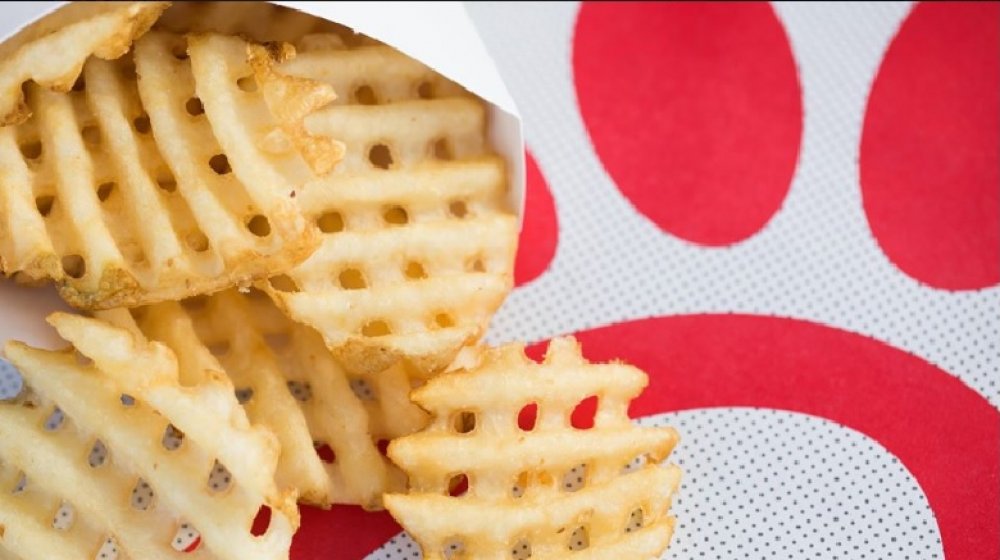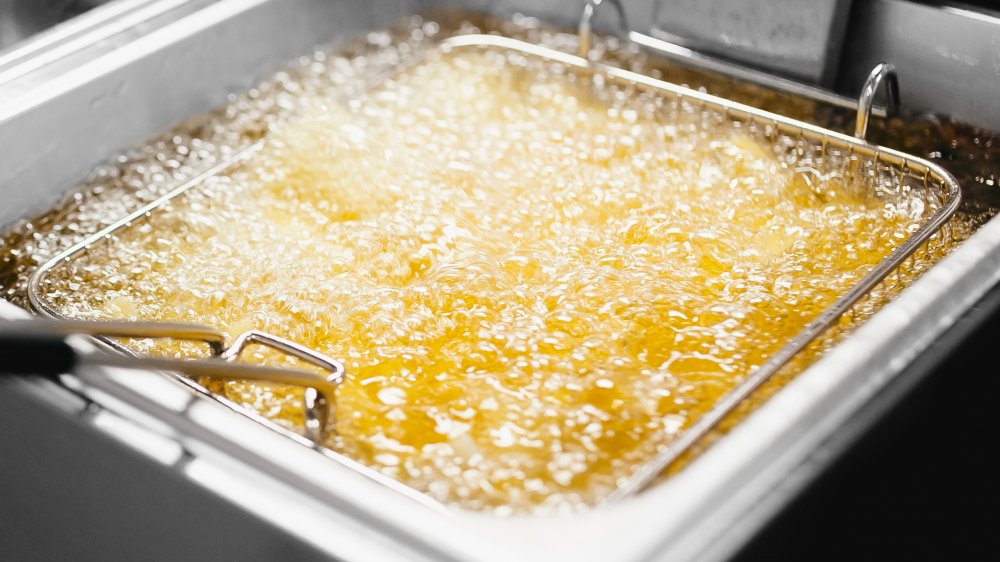The Ingredient You'd Be Surprised Is Inside Chick-Fil-A's Waffle Fries
Nobody wants to hear all is not as it seems when it comes to Chick-fil-A's waffle fries. After all, these fries are our reliable companions to chicken sandwiches and nuggets, and our vehicle of choice for Chick-fil-A's dreamy dipping sauces. There's no way they have a dark side, right? Well, it turns out, Chick-fil-A has some tricks up its sleeve when it comes to securing the world's love for these waffle-cut spuds.
On the surface, Chick-fil-A's fries seem pretty pure and simple: potatoes, cut into a charming shape, fried in oil, and seasoned with salt. Are they just plain ol' potatoes though? And is the oil just oil? No and no. On the ingredients list for Chick-fil-A's waffle fries, the potatoes are followed by some interesting subtext, including something that can best be described as "not found in nature." And the oil is listed as containing an ingredient with 20 letters in its name and more "methyls" and "polys" than seems necessary when we're talking about cooking oil. So what's the point of all this extra stuff in our fries? Let's find out.
Chick-fil-A uses an additive to make their waffle fries better
Vegetable oil, disodium dihydrogen pyrophosphate, and dextrose all fall into the parenthesis behind the word "potato" in the CFA waffle fries ingredients list. We can skim past the vegetable oil, although it's unclear why it would be listed as part of a potato, and the dextrose as well (that's just a fancy word for sugar).
Let's take a closer look at that monster of a term: disodium dihydrogen pyrophosphate. This ingredient is actually found in nature but, by the time science gets a hold of it, it's morphed into something quite unnatural. According to New Hope, disodium dihydrogen pyrophosphate begins as a naturally-occurring mineral called phosphate, which comes from mined phosphate rock. The phosphate is purified, which isolates the phosphorus, then further processed with sodium and other molecules to become a synthetic chemical.
No part of this process sounds very appetizing, but the point of using disodium dihydrogen pyrophosphate in Chick-fil-A waffle fries is to do just that: make them appetizing. It's a color preserver and prevents the potatoes from turning black. As with most food additives, phosphates come with potential health concerns, but are relatively harmless if consumed in small amounts — you have to take in a ton to see any potential issues, such as bone or tooth decay. It's up to you to decide if the risk is worth the reward of potato-colored waffle fries.
There's a questionable ingredient in Chick-fil-A's fry oil
Moving along on the waffle fry ingredients list, you'll come to sea salt, canola oil, and another set of parenthesis explaining the canola oil is high oleic oil with dimethylpolysiloxane added as an anti-foaming agent. Umm, what? Here's the good news: high oleic oil is a good thing. It means the oil is high in monounsaturated fats, which make it shelf-stable, but is free of evil trans fats, per Eating Made Easy.
Here's the bad news: Dimethylpolysiloxane is a form of silicone and it's added to cooking oil to prevent it from bubbling and splashing when hot, according to Food Additives. So, the use of this ingredient in Chick-fil-A's waffle fry preparation likely comes down to food safety, as it protects their fry cooks from being burned by bubbly hot oil. Dimethylpolysiloxane can also be found in chewing gum, fruit juices, and certain soups and broths. It's approved by the FDA and probably pretty benign, but you may have to ask yourself if you're ok with a teensy side of silicone with your Chick-fil-A waffle fries. Considering they are the number one item on Chick-fil-A's menu, it sounds like most of us don't mind at all.


